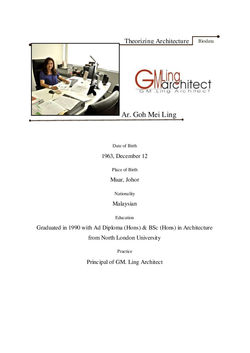Tan Woan Tyng
0312725
Taylor's University Lakeside Campus
School of Architecture, Building & Design
Bachelor of Science (Honours) (Architecture)

Project Theorizing Architecture (Individual)
This project attempts to convey an understanding of architect’s architectural theory through a direct observation and analysis of his/her buildings. Using architecture as primary text, this project claims that the world of form is not arbitrary but displays an internal logic that has the capacity to convey meaning. Analytical illustrations are used extensively to reveal the conceptual and experiential order of the architecture.It will support students’ learning since doing architecture can be developed by studying the work of others.
Brief
This project comprises of 2 parts:
• PROJECT PART I: ANALYSING SELF (30%)
• PROJECT PART II: ANALYZING AND THEORIZING ARCHITECTURE (30%)
Such a project is a multi-step, multi-level process that involves formulating an interesting question, finding useful information and readings, shifting out the irrelevant information, formulating an argument, drafting it up, and polishing it into a final piece of clear, persuasive research essay that is reinforced by key illustrations.

THEORIES OF ARCHITECTURE AND URBANISM (ARC2224)
Module Synopsis
The subject offers a thematic inquiry into architectural theory in the broader context of philosophical schools of thought and cultural and social conditions, which include modernism, postmodernism, phenomenology, semiotics, post-structuralism, and deconstruction. These themes will guide the organization of weekly lecture and discussions, which will proceed from the establishment of a basic theoretical apparatus to the examination of specific cases. These will supply us with tools for the analysis of specific architectural situations. Students will develop a written synopsis of a designated reading, and an in-depth and analytical research paper on the designated topic.
Module Learning Outcomes
Upon successful completion of the module, students will be able to:
1. Describe the theoretical issues related to design through study of architecture and urbanism and its related studies
2. Identify the different architectural theories which inform the development of architecture and urban forms
3. Analyze and critique the relationship between architecture and its social, cultural, and intellectual context
4. Analyze architecture and urban forms in relation to relevant architectural theories
5. Produce, orally and in writing, a critical interpretation of architecture and urbanism in relation to relevant
theories within the contemporary discourse of architecture
PROJECT PART I: ANALYSING SELF (30%)
Part 1 of the project is to provide information on the architect in order to comprehend personal attributes that contribute to the construction of architectural theory.
Stage 1: To gather information on the architect and his/her works
(Students can choose to work in a group of 3) (10%)
a) Biodata
b) List of work + pictures + address
c) List of references
 Biodata Ar.Goh Mei Ling-page-001.jpg |  Biodata Ar.Goh Mei Ling-page-002.jpg |  Biodata Ar.Goh Mei Ling-page-003.jpg |
|---|---|---|
 Biodata Ar.Goh Mei Ling-page-004.jpg |  Biodata Ar.Goh Mei Ling-page-005.jpg |  Biodata Ar.Goh Mei Ling-page-006.jpg |
 Biodata Ar.Goh Mei Ling-page-007.jpg |
Stage 2: To Analyse ‘Self” (Individual) (20%)
a) Childhood (My Part)
b) Education (Yaow Ning)
c) Working experience (Minqi)
Education and Working Experience is in pdf file.



PROJECT PART II: ANALYZING AND THEORIZING ARCHITECTURE (30%)
Part 2 of the project emphasises architecture is like language with vocabulary, grammatical structure; both physical and intellectual. Through certain arrangement, it carries messages and communicates meanings. Nevertheless, in order to understand architecture, one must be aware of the conditions within which they are employed.
TASK:
Stage 3: To analyse architecture (choose a particular building by the architect) based on: (30%)
a) External contributing factors (min 3)
b) Analysis diagrams (plan, section, elevation)
c) To theorize architecture based on analysis of self & architecture
The project that i chose is a low cost apartment located at Hulu Langat Selangor. Well it is a very challenging project as i can't get to get others project from the architect. Therefore, i accepted the challenge and progress with the essay.




 |  |
|---|---|
 |  |
 |  |
 |  |
 |  |
 |  |
 |
 |  |  |
|---|
Learning Outcomes
1.Analyse architecture and urban forms in relation to relevant architectural theories
2.Analyse and critique the relationship between architecture and its social, cultural and intellectual context
3.Produce, orally and in writing, a critical interpretation of architecture and urbanism in relation to relevant theories within the contemporary discourse of architecture
Synopsis: Interpreting Architecture (Group Work)
This synopsis attempts to interpret architecture according to established architectural theory and conditions within which architecture is done.
In a group of 4/5 students, students are to present a synopsis of the given reading during the seminar sessions. It is intended to provide each student with the opportunity to share their knowledge with the class, and to help promote student discussions.




Learning Outcomes
1. Describe the theoretical issues related to design through study of architecture and urbanism and its related studies
2. Relate architectural theories to contemporary architecture and urban forms